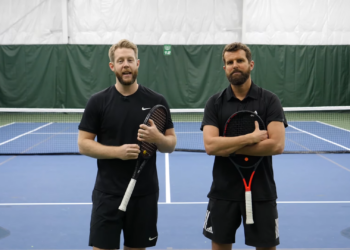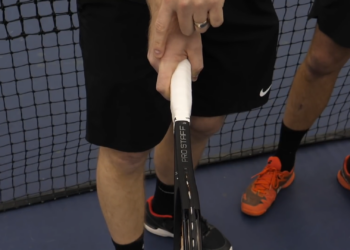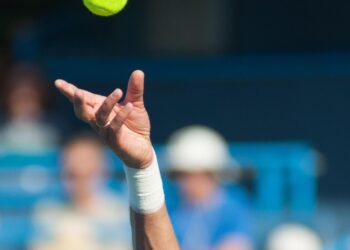“Move your feet” might be the most overused, least understood phrase in tennis coaching.
I’ve seen it shouted from the sidelines, whispered by frustrated doubles partners, and scrawled on practice notes like it’s some magical fix. Most players don’t actually know how to move their feet. They hear it, nod, and go right back to drifting, lunging, or planting too soon.
Footwork is the secret sauce. It’s not just about being fast. It’s about getting to the ball early, hitting it in balance, recovering like a pro, and yes, even finding that extra 10 MPH of power you’ve been chasing on your forehand.
Here’s what most players miss: poor movement is the root cause of a ton of problems you think are technical.
If your timing’s off, if your consistency falls apart under pressure, or if you feel like your game disappears when you face better competition, your feet might be the culprit.
Let’s stop guessing and start moving with purpose.
What Tennis Footwork Actually Is and Isn’t
Footwork = Positioning, Not Just Running Fast
Let’s flip the script right now: footwork isn’t about running more, it’s about being in the right place sooner.
If you’re constantly sprinting full tilt just to make contact, your footwork isn’t working for you; it’s working against you. Great footwork is actually what allows you to move less and hit more.
Footwork is about positioning, and that starts with anticipation.
The best movers in the game, guys like Djokovic and Federer aren’t fast because they’re physically quicker than everyone else. They’re fast because they read the play early and make their first step before you’ve even swung.
That early setup is everything. When you’re in the right position before the ball bounces, your shot selection opens up, your balance is locked in, and your confidence skyrockets.
When you’re late, even by half a second, you’re reaching, adjusting mid-swing, or throwing your body off balance just to stay in the point.
Balance beats hustle every time.
Watch any ATP or WTA match and notice this: the pros never look rushed. It’s because their movement puts them in a hitting position early, not desperately.
Footwork isn’t a side dish, it’s the main course if you want to level up.
6 Core Tennis Footwork Movements You Need To Master
Let’s break down the six movement patterns that drive every point, every rally, and every shot you’ll hit. These are the foundation of good tennis at any level.
If you’ve ever felt “stuck,” “late,” or like your footwork falls apart in matches, mastering these six will change everything.
1. The Ready Position & Split Step
The ready position is your launch pad. Feet shoulder-width apart, knees bent, weight slightly forward on the balls of your feet. This athletic stance primes your body for quick, reactive movement in any direction.
But the real magic happens with the split step, that little hop you take just as your opponent hits the ball.
Time it right, and your legs load like springs, giving you explosive push-off energy in the direction of the ball. Mistime it, even by half a beat, and you’ll be a step late, off balance, or frozen.
Fast rally? Split earlier. Slower rally or playing a pusher? Delay the split until you’re sure where the ball’s going. This nuance is what separates players who “feel quick” from those who always seem half a step behind.
2. First Step & Directional Push
This is where most players lose time, that first move after the split. Are you reacting? Or initiating?
When you split step, don’t just wait to see what happens. As soon as you recognize direction, explode with a directional push off the opposite foot.
If the ball is going left, push hard off your right foot to launch into the left.
That first explosive step doesn’t just get you there quicker, it gets you there under control. And when you arrive early and in balance, your shot options multiply. This is how you turn defense into offense.
3. Shuffle vs. Cross-Step: When to Use Each
Baseline rallies live and die on lateral coverage. Knowing when to shuffle and when to cross-step is critical.
Use shuffles for short distances, quick sidesteps that keep your hips square to the net and let you stay centered between shots. They’re stable and quick but limited in range.
When you need to cover more ground, like tracking a deep cross-court forehand, go to the cross-step, cross one foot over the other for maximum reach and speed. It’s not as stable, but it gets you there.
Pro tip: shuffle when you can, cross-step when you must. The faster you can switch between the two, the more dynamic your court coverage becomes.
4. The Adjustment Step
Ever hit the ball off your back foot and wonder why it lacked power or control? That’s an adjustment step issue.
Once you’ve gotten to the ball, the real work begins, fine-tuning your position to hit the ball in your strike zone.
This is where small, rapid adjustment steps come into play. They help you realign your body, get balanced, and set up the ideal contact point.
Skipping this step leads to reaching, mishits, and off-balance strokes. Adding it, even if you’re a half-step late, can save a rally and win you the point.
5. Backpedal vs. Pivot Footwork
Let’s talk about those tricky floaters and short balls.
If you’re retreating for a lob, don’t just backpedal blindly, that’s a rolled ankle waiting to happen. Instead, pivot and run.
Open up your hips, cross-step backward, and stay low. You’ll get there faster, and you’ll be in a safer, stronger position to reset the point.
For short balls, it’s all about closing in under control. Pivot forward, stay compact, and recover quickly to avoid getting burned on the next shot.
The best players treat short balls like opportunities, not chaos.
6. Repositioning Footwork (The Most Overlooked One)
Here’s the part nobody practices: what you do after you hit the ball.
Footwork doesn’t end when you strike, it begins again. You’ve got to recover to neutral, and do it fast.
The goal isn’t to guess where the next ball is going, it’s to get back to a position where you can move anywhere efficiently.
Use quick recovery steps, often a mix of cross-steps and small shuffles, to get back to your home base on the court.
Staying in the rally starts the moment your shot leaves your racquet. Most players don’t train this. That’s why they look smooth in drills and scrambled in real points.
These six movement patterns aren’t optional, they’re the foundation of every effective rally you’ll ever play.
The good news? You don’t need to be the fastest or most athletic player on the court. You just need to understand how to move smarter.
Best Drills To Improve Tennis Footwork (With Progressions)
So now that you’ve got the six core footwork movements under your belt, the next question is: how do you actually train them?
Whether you’re just starting out or you’ve been hitting for years, footwork improvement doesn’t require magic, it just requires the right drills, practiced with intent.
Here’s how we build it at PlayYourCourt: start simple, progress to dynamic, then mimic match play.
And the best part? A lot of these drills can be done with no court, no ball, and no hitting partner.
Beginner Drills for Movement Awareness
If you’re new to footwork training, or if you’ve ever been told “move your feet” and had no idea how, this is where you start. These drills are about building awareness, balance, and muscle activation.
Shadow Tennis with Unit Turns
Grab your racquet and practice strokes with no ball, just move and swing through your forehand and backhand. Focus on your unit turn (that coil of your shoulders and hips) and match each shot with split step > directional push > setup.
This reinforces the rhythm of real movement without the distraction of the ball.
No-Shoes Balance Drills (PlayYourCourt Pro Tip)
Ditch the shoes and stand on one foot while mimicking your forehand or backhand motion. This forces your stabilizer muscles to activate and builds foot sensitivity.
Spread your toes to grip the ground and work on subtle balance shifts. It’s simple, but incredibly effective for rewiring how your feet communicate with the rest of your body.
“Toe-Spread” Method to Activate Stabilizers
This sounds small, but it’s huge. Practice spreading your toes wide (like starfish) while standing in ready position.
This wakes up the small muscles in your feet and strengthens your arch control, giving you more control when shifting, pushing off, or adjusting.
Intermediate Agility & Balance Builders
Now that you’ve got the awareness dialed in, let’s build speed and precision. These drills improve reaction time, lateral quickness, and balance under pressure.
Speed Ladder Patterns + Split-Step Combos
Use a ladder (or chalked rectangles on the sidewalk) to run through patterns like in-in-out-out or side shuffles. After each set, simulate a split step and first push toward an imaginary shot.
Bonus: add shadow swings at the end of each sequence to blend movement and stroke prep.
Lateral Cone Drills: Approach, Hit, Recover
Set up three cones: center, wide forehand, and wide backhand. From the center cone, split-step, move to either side, simulate a shot, then recover back to center.
This teaches both lateral push-off and the often-ignored repositioning footwork.
Plyometric Progressions
Time to add pop. Use squat jumps, ice skaters, and box hops to build explosive power in your legs.
These drills increase first-step quickness, especially important for reacting to aggressive shots or closing to the net.
Advanced Game-Like Footwork Routines
This is where we make footwork match-ready. The drills here combine decision-making, stroke execution, and endurance, just like in real points.
Footwork + Forehand/Backhand Decision Drills
Have a coach or partner call out “forehand” or “backhand” as you split step. React with directional movement and swing through the appropriate side.
This blends reactive footwork, directional push, and adjustment steps under pressure.
Partner-Fed Point Simulation
One of our favorite PlayYourCourt formats: your partner feeds random deep and short balls across both sides of the court.
Your job is to track, strike, and recover, no stopping. It’s not about winners; it’s about staying balanced and in the rally, no matter what’s thrown at you.
Fatigue Drills for End-of-Match Footwork
Here’s a truth bomb: your footwork is only as good as it is when you’re tired. Run a set of cone drills, then shadow stroke a full rally sequence, split, move, strike, recover, with as much intensity as you can.
These fatigue-aware sessions train you to move with precision even in the third set.
Mistakes That Sabotage Your Footwork
Even with good intentions and decent effort, many players stay stuck because of a few habitual missteps.
These are the silent killers of movement, the footwork faults that wreck your rhythm, tire you out, and cost you winnable points.
Waiting Too Long To Move
If you’re waiting until the ball is halfway to you before taking your first step, you’re already too late. This delay turns every rally into a scramble, and no matter how good your strokes are, you’ll always feel rushed.
The Fix: Anticipate.
Start reading cues before your opponent makes contact, watch their shoulder rotation, racket angle, and body position. Combine this with a well-timed split step as they hit, and you’ll be exploding out of your stance before the ball crosses the net.
This is the difference between reacting to shots and preparing for them, a mindset shift that transforms your movement and your confidence.
Jumping Instead of Stepping
Many players (especially when they’re nervous) hop in place or take big bounding steps. It feels active, but it’s deceptive, you’re burning energy, killing your balance, and making yourself late to recover.
The Fix: Stay grounded with fast, light feet.
The goal is low, economical steps, not high-impact hops. Think “cat feet,” not kangaroo legs.
PlayYourCourt coaches train this using rope skipping and ladder drills to build rhythm and minimize wasted movement. You want to float across the court, not stomp your way through it.
Not Recovering to Neutral
Here’s a huge one that nobody teaches at the rec level: footwork doesn’t end when you hit the ball.
Players often admire their shot (or worse, stand flat-footed watching it), leaving themselves totally exposed for the next ball. The result? You’re always reacting late, out of breath, and out of position.
The Fix: Add a recovery step to every shot you practice.
Make it automatic, split, move, strike, recover.
Whether you’re feeding balls, doing shadow drills, or playing points, you should always finish your shot by moving back to a neutral, ready position.
Every mistake here is fixable.
You don’t need more hustle, you need better habits. And when those habits are reinforced by thoughtful drills, matched movement partners, and focused coaching, the progress is lasting.
How To Build Footwork Training Into Your Practice Routine
This is where it all comes together, because even the best footwork drills don’t mean much if they live in a vacuum.
The players who improve the fastest are the ones who weave footwork into everything they do, from warm-ups to rally play to match prep.
Footwork Warm-Up Routine (10 minutes)
You don’t need a court to get your feet ready, you just need 10 minutes of targeted activation.
This quick warm-up sequence not only boosts performance but dramatically reduces your risk of injury.
- Dynamic Skips
Start with forward and backward skips. These wake up your hip flexors and fire your glutes, both key to lateral movement.
- Split-Step Activation
Shadow split-steps in rhythm with an imaginary opponent’s shot. Train your body to bounce on contact, not after. Throw in directional pushes to both sides to mimic first-step reactions. - Short Ladder or Cone Work
Use agility ladders or 3–4 cones for quick-feet drills. Think in-in-out-out, lateral shuffles, and forward bursts. Even 2–3 minutes here fires up your nervous system for match-like movement.
This simple circuit primes your footwork before you even pick up a racquet.
Integrate Into Stroke Practice
Too many players separate “movement drills” from “hitting practice.” But if you’re not moving during your stroke work, you’re not practicing real tennis.
Combine movement patterns with forehands/backhands.
Have your coach or partner feed balls to alternating corners. Focus not just on your stroke, but on your split, first step, adjustment step, and recovery. This sequence should be muscle memory.
Practice “hit + recover” like a match.
After every shot, move back to center. Even if you know the next ball is coming cross-court again, build the habit of recovering like you’re in a real point.
This is one of the biggest mindset shifts we train in PlayYourCourt workshops and it’s what helps our members translate drill improvements into match wins.
Track Your Progress
Use your phone (leaned against a fence or water bottle) to record shadow drills, rally sequences, or live points. Watch for:
- Split step timing
- Balance at contact
- Adjustment steps before the swing
- How quickly you recover after a shot
Even five minutes of video a week can expose the gaps in your movement and more importantly, show you how much you’re improving.
Remember: footwork doesn’t need its own practice session. It just needs to live inside everything else you do.
Make it part of your rhythm, part of your swing, and part of your strategy and you’ll move, hit, and win like a whole new player.
Now You Know What “Move Your Feet” Really Means
Roger Federer once said, “Footwork is everything. It’s what gets you to the ball in time to hit your best shot.”
If your game feels stuck, if you’re battling inconsistency, or if you’re constantly chasing the ball instead of controlling the point, it’s your movement that needs work, not just your mechanics.
You don’t have to be born fast, tall, or ridiculously athletic to move like a tennis player. You just need the right patterns, the right drills, and a system that makes your footwork automatic.
You can be balanced. You can be quick. And most importantly, you can play with more confidence, regardless of your level.
We built PlayYourCourt for players exactly like you, recreational adults who are hungry to improve but frustrated by dead-end coaching, YouTube rabbit holes, and one-size-fits-all instruction.
You’ve heard “move your feet” a hundred times. Now you finally know what it means and how to do it.
👉 Try 7 Days of Game Improvement Coaching Free
You don’t need to guess anymore. You just need a plan that works. And we’ve built it for you.
Let’s move.



